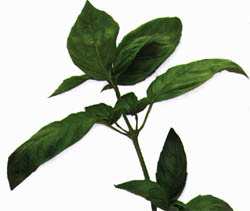|
|
Basil
(Ocimum basilicum)

Native to
Asia this "king of herbs" is one of the most widely used
herbs in the world. Basil has a warm spicy smell and pungent flavor
(similar
to licorice and cloves), that does wonders for a Mediterranean cookery.
Best known as the base of Italian PESTO SAUCE of Genoa and a similar
sauce called Pistou in France, basil becoming more and more popular in
American cuisine.
Basil combines well with olive oil, garlic, tomatoes and lemon, both
raw and cooked. Basil leaves give a wonderful flavor to a tomato salad
and tossed green salad. It is better to tearing rather than chopping
the
leaves as this helps to retain more flavor. You can put basil in
omelets
and other egg dishes. Mix basil with olive oil and garlic and stir it
into
hot pasta. Put basil in eggplant dishes, potatoes, rice, beans, sauces
for fish, veal, lamb and chicken or arrange whole basil leaves over a
pizza.
In hot dishes is best to use only a little
during a cooking and add the rest at the last minute, because prolonged
cooking reduces aroma and flavor.
Known best for its culinary use, basil has also earned a considerable
symbolic and medicinal reputation, particularly in Asia and Europe. In
India it is sacred to Vishnu; in Jewish lore the herb provided strength
during fasts. For the Greeks basil has symbolized hate, for Italians it
has symbolized love and for French royalty.
Apart
from the Sweet basil or
Garden basil (used for all Western cooking) there are many other types
of basil:
|
|
| Did You Know? |
| Sweet
basil is the most common and popular
basil, used for all Western cooking. |
|
Medicinal Use:
In ancient China, basil tea has been used to treat stomach problems. It
was also used for fighting dental plaque, calming the nerves,
regulating menstruation and reducing fever. Although little evidence
exist to support many of basil's applications, studies have confirmed
effectiveness for its most common use: the relief of flatulence. It was
also found that basil oil is slightly antiseptic, but it is not
recommended for pregnant or nursing women and children.
|
|
Basil is easy to grow,
and its minty licorice fragrance perks up any garden. If you don't have
a garden, you can grow basil in window box or in a planter. To find out
more about growing herbs visit our page Growing Culinary Herbs.
|
|
Basil has a comprehensive
list of cultivated varieties (cultivars). They are used in a variety of
ways: as culinary herbs, landscape plants, healing herbs, teas, and for
worship. All true basils are species of genus Ocimum. The genus is
particularly diverse, and includes annuals, non-woody perennials and
shrubs native to Africa and other tropical and subtropical regions of
the Old and New World.
|
|